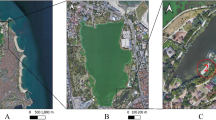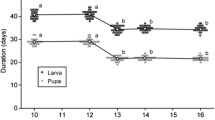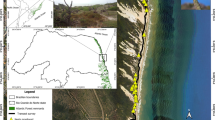Abstract
The brown widow spider, Latrodectus geometricus, is a hazardous and highly invasive species globally. One of the suggested mechanisms enhancing this spider’s invasiveness is lower susceptibility to natural enemies compared to other widow species. The parasitoid wasp, Philolema latrodecti, is known to attack egg sacs of L. geometricus, as well as those of other species of Latrodectus. Despite its potential importance as a natural enemy of L. geometricus, little is known about the development of this wasp and factors mediating its parasitism success. We investigated the development of this parasitoid in two widow spider host species, one native to Israel, the white widow, L. pallidus, and the invasive brown widow, L. geometricus. We compared wasp developmental success in egg sacs exposed to increasing wasp densities. We found increased wasp emergence and brood size, and smaller emerging wasp body size with increasing wasp density. Across all wasp densities, more and larger parasitoids developed in the egg sacs of the native host species, L. pallidus, compared to the invasive host species, L. geometricus. Parasitoid sex ratio was highly female-biased and the proportion of males increased with wasp density, suggesting local mate competition. Overall, our results suggest that L. pallidus is a better host for the egg sac parasitoid P. latrodecti, which could give a competitive advantage to the less-affected invasive brown widow spider.




Similar content being viewed by others
Data availability
All data associated with this manuscript are available on the Dryad data repository at https://doi.org/10.5061/dryad.tb2rbp053
References
Abhilasha D, Joshi J (2009) Enhanced fitness due to higher fecundity, increased defence against a specialist and tolerance towards a generalist herbivore in an invasive annual plant. J Plant Ecol 2(2):77–86. https://doi.org/10.1093/jpe/rtp008
Abram PK, Gariepy TD, Boivin G, Brodeur J (2014) An invasive stink bug as an evolutionary trap for an indigenous egg parasitoid. Biol Invasions 16(7):1387–1395. https://doi.org/10.1007/s10530-013-0576-y
Abram PK, Mills NJ, Beers EH (2020) Review: Classical biological control of invasive stink bugs with egg parasitoids—what does success look like? Pest Manag Sci 76(6):1980–1992. https://doi.org/10.1002/ps.5813
Austin AD (1985) The function of spider egg sacs in relation to parasitoids and predators, with special reference to the Australian fauna. J Nat Hist 19(2):359–376. https://doi.org/10.1080/00222938500770261
Barrett M, Schmidt JM (1991) A comparison between the amino acid composition of an egg parasitoid wasp and some of its hosts. Entomol Exp Appl 59(1):29–41. https://doi.org/10.1111/j.1570-7458.1991.tb01483.x
Bates D, Mächler M, Bolker B, Walker S (2015) Fitting linear mixed-effects models using lme4. J Stat Softw 67(1):1. https://doi.org/10.18637/jss.v067.i01
Bezemer TM, Mills NJ (2003) Clutch size decisions of a gregarious parasitoid under laboratory and field conditions. Anim Behav 66(6):1119–1128. https://doi.org/10.1006/anbe.2003.2296
Birkhofer K, Gossner MM, Diekötter T, Drees C, Ferlian O, Maraun M, Scheu S, Weisser WW, Wolters V, Wurst S, Zaitsev AS, Smith HG (2017) Land-use type and intensity differentially filter traits in above- and below-ground arthropod communities. J Anim Ecol 86(3):511–520. https://doi.org/10.1111/1365-2656.12641
Boivin G, Martel V (2012) Size-induced reproductive constraints in an egg parasitoid. J Insect Physiol 58(12):1694–1700. https://doi.org/10.1016/j.jinsphys.2012.10.014
Bowden JJ, Buddle CM (2012) Egg sac parasitism of Arctic wolf spiders (Araneae: Lycosidae) from northwestern North America. J Arachnol 40(3):348–350. https://doi.org/10.1636/P11-50.1
Burks BD (1971) A Synopsis of the genera of the family Eurytomidae (Hymenoptera: Chalcidoidea). Trans Am Entomolog Soc (1890) 97(1):1–89
Callaway RM, Ridenour WM (2004) Novel weapons: Invasive success and the evolution of increased competitive ability. Front Ecol Environ 2(8):436–443. https://doi.org/10.1890/1540-9295(2004)002[0436:NWISAT]2.0.CO;2
Campbell LD, Salazar AR, Rypstra AL (2020) Contests between web spiders: patience as a strategy for successful invasion. Biol Invasions 22(5):1737–1752. https://doi.org/10.1007/s10530-020-02216-6
Ceryngier P, Nedvěd O, Grez AA, Riddick EW, Roy HE, San Martin G, Steenberg T, Veselý P, Zaviezo T, Zúñiga-Reinoso Á, Haelewaters D (2018) Predators and parasitoids of the harlequin ladybird, Harmonia axyridis, in its native range and invaded areas. Biol Invasions 20(4):1009–1031. https://doi.org/10.1007/s10530-017-1608-9
Charnov EL (1982) The theory of sex allocation. Monogr Popul Biol 18:1–355
Cobb LM, Cobb VA (2004) Occurrence of Parasitoid Wasps, Baeus sp., and Gelis sp., in the egg sacs of the wolf spiders Pardosa moesta and Pardosa sternalis (Araneae, Lycosidae) in Southeastern Idaho. Can Field Nat 118(1):1. https://doi.org/10.22621/cfn.v118i1.894
Cronin JT, Strong DR (1993) Superparasitism and mutual interference in the egg parasitoid Anagrus delicatus (Hymenoptera: Mymaridae). Ecol Entomol 18(4):293–302
Danielsen DWR, Clarke DE, Valle SJ, Ansalmo AA, Vincent LS, Vetter RS (2014) Natural egg sac clutch size of the brown widow spider, Latrodectus geometricus (Araneae: Theridiidae) in southern California. Bull South Calif Acad Sci 113(2):100–102. https://doi.org/10.3160/0038-3872-113.2.100
Dorn S, Beckage NE (2007) Superparasitism in gregarious hymenopteran parasitoids: ecological, behavioural and physiological perspectives. Physiol Entomol 32(3):199–211. https://doi.org/10.1111/j.1365-3032.2007.00576.x
Eggleton P, Belshaw R (1992) Insect parasitoids: an evolutionary overview. Philos Trans R Soc Lond Series B Biol Sci 337(1279):1–20. https://doi.org/10.1098/rstb.1992.0079
Eggleton P, Gaston KJ (1990) “Parasitoid” species and assemblages: Convenient definitions or misleading compromises? Oikos 59(3):417–421. https://doi.org/10.2307/3545155
Elton CS (1958) The reasons for conservation. In: Elton CS (ed) The ecology of invasions by animals and plants. Springer, US, pp 143–153. https://doi.org/10.1007/978-1-4899-7214-9_8
Farahani HK, Goldansaz SH (2013) Is host age an important factor in the bionomics of Apanteles myeloenta (Hymenoptera: Braconidae)? Eur J Entomol 110(2):277–283. https://doi.org/10.14411/eje.2013.041
Fei M, Gols R, Harvey JA (2023) The biology and ecology of parasitoid wasps of predatory arthropods. Ann Rev Entomol. https://doi.org/10.1146/annurev-ento-120120-111607
Finch O (2005) The parasitoid complex and parasitoid-induced mortality of spiders (Araneae) in a Central European woodland. J Nat Hist 39(25):2339–2354. https://doi.org/10.1080/00222930502005720
Fox J, Weisberg S (2019) An R companion to applied regression (Third edition). Sage. https://socialsciences.mcmaster.ca/jfox/Books/Companion/
Goddard J, Upshaw S, Held D, Johnnson K (2008) Severe reaction from envenomation by the brown widow spider, Latrodectus geometricus (Araneae: Theridiidae). South Med J 101(12):1269–1270. https://doi.org/10.1097/smj.0b013e31817f4d89
Godfray HCJ (1994) Parasitoids: behavioral and evolutionary ecology, vol 67. Princeton University Press, New York. https://doi.org/10.2307/j.ctvs32rmp
Grenier S, Basso C, Pintureau B (2001) Effects of the host species and the number of parasitoids per host on the size of some Trichogramma species (Hymenoptera: Trichogrammatidae). Biocontrol Sci Tech 11(1):21–26. https://doi.org/10.1080/09583150020029709
Gu H, Dorn S (2003) Mating system and sex allocation in the gregarious parasitoid Cotesia glomerata. Anim Behav 66(2):259–264. https://doi.org/10.1006/anbe.2003.2185
Hamilton WD (1967) Extraordinary sex ratios. Science 156(3774):477–488. https://doi.org/10.1126/science.156.3774.477
Hardy ICW (1992) Non-binomial sex allocation and brood sex ratio variances in the parasitoid hymenoptera. Oikos 65(1):143–158. https://doi.org/10.2307/3544897
Hardy ICW (1994) Sex ratio and mating structure in the parasitoid Hymenoptera. Oikos 69(1):3–20. https://doi.org/10.2307/3545278
Harvey JA (2000) Dynamic effects of parasitism by an endoparasitoid wasp on the development of two host species: implications for host quality and parasitoid fitness. Ecol Entomol 25(3):267–278. https://doi.org/10.1046/j.1365-2311.2000.00265.x
Harvey JA (2005) Factors affecting the evolution of development strategies in parasitoid wasps: the importance of functional constraints and incorporating complexity. Entomol Exp Appl 117(1):1–13. https://doi.org/10.1111/j.1570-7458.2005.00348.x
Harvey JA, Poelman EH, Tanaka T (2013) Intrinsic inter- and intraspecific competition in parasitoid wasps. Annu Rev Entomol 58(1):333–351. https://doi.org/10.1146/annurev-ento-120811-153622
Hassell MP, Waage JK (1984) Host-parasitoid population interactions. Annu Rev Entomol 29(1):89–114. https://doi.org/10.1146/annurev.en.29.010184.000513
Heimpel GE, Mills NJ (2017) Biological control. Cambridge University Press, Cambridge
Herre EA (1985) Sex ratio adjustment in fig wasps. Science 228(4701):896–898. https://doi.org/10.1126/science.228.4701.896
Herre EA (1987) Optimality, plasticity and selective regime in fig wasp sex ratios. Nature 329(6140):6140. https://doi.org/10.1038/329627a0
Hirna A (2017) First record of the alien spider species Mermessus trilobatus (Araneae: Linyphiidae) in Ukraine. Arachnologische Mitteilungen 54:41–43. https://doi.org/10.5431/aramit5409
Hogg BN, Daane KM (2010) The role of dispersal from natural habitat in determining spider abundance and diversity in California vineyards. Agr Ecosyst Environ 135(4):260–267. https://doi.org/10.1016/j.agee.2009.10.004
Holden CA, Bailey JP, Taylor JE, Martin F, Beckett P, McAinsh M (2022) Know your enemy: Application of ATR-FTIR spectroscopy to invasive species control. PLoS ONE 17(1):e0261742. https://doi.org/10.1371/journal.pone.0261742
Hopper K (1999) Risk-spreading and bet-hedging in insect population biology. Annu Rev Entomol 44:535–560. https://doi.org/10.1146/annurev.ento.44.1.535
Hothorn T, Bretz F, Westfall P (2008) “Simultaneous Inference in General Parametric Models.” Biom J 50(3):346–363
Huang J, Hua H-Q, Wang L-Y, Zhang F, Li Y-X (2017) Number of attacks by Trichogramma dendrolimi (Hymenoptera: Trichogrammatidae) affects the successful parasitism of Ostrinia furnacalis (Lepidoptera: Crambidae) eggs. Bull Entomol Res 107(6):812–819. https://doi.org/10.1017/S0007485317000335
Hulme PE (2009) Trade, transport and trouble: managing invasive species pathways in an era of globalization. J Appl Ecol 46(1):10–18. https://doi.org/10.1111/j.1365-2664.2008.01600.x
Keasar T, Segoli M, Barak R, Steinberg S, Giron D, Strand MR, Bouskila A, Harari AR (2006) Costs and consequences of superparasitism in the polyembryonic parasitoid Copidosoma koehleri (Hymenoptera: Encyrtidae). Ecological Entomology 31(3):277–283. https://doi.org/10.1111/j.1365-2311.2006.00788.x
Khafagi WE, Hegazi EM (2008) Does superparasitism improve host suitability for parasitoid development? A case study in the Microplitis rufiventris-Spodoptera littoralissystem. Biocontrol 53(3):427–438. https://doi.org/10.1007/s10526-007-9078-0
King BH (1987) Offspring sex ratios in parasitoid wasps. Q Rev Biol 62(4):367–396. https://doi.org/10.1086/415618
Le Masurier AD (1991) Effect of host size on clutch size in Cotesia glomerata. J Anim Ecol 60(1):107–118. https://doi.org/10.2307/5448
Levy G, Amitai P (1983) Revision of the widow-spider genus Latrodectus (Araneae: Theridiidae) in Israel. Zool J Linn Soc 77(1):39–63. https://doi.org/10.1111/j.1096-3642.1983.tb01720.x
Mackauer M, Sequeira R, Otto M (1997) Growth and development in parasitoid wasps: adaptation to variable host resources. In: Dettner K, Bauer G, Völkl W (eds) Vertical food web interactions: evolutionary patterns and driving forces. Springer, London, pp 191–203. https://doi.org/10.1007/978-3-642-60725-7_11
Marie J, Vetter RS (2015) Establishment of the brown widow spider (Araneae: Theridiidae) and infestation of its egg sacs by a parasitoid, Philolema latrodecti (Hymenoptera: Eurytomidae), in French Polynesia and the Cook Islands. J Med Entomol 52(6):1291–1298. https://doi.org/10.1093/jme/tjv127
Michalko R, Pekár S, Dul’a M, Entling MH (2019) Global patterns in the biocontrol efficacy of spiders: a meta-analysis. Glob Ecol Biogeogr 28(9):1366–1378. https://doi.org/10.1111/geb.12927
Moravcová L, Pyšek P, Jarošík V, Pergl J (2015) Getting the right traits: reproductive and dispersal characteristics predict the invasiveness of herbaceous plant species. PLoS ONE 10(4):e0123634. https://doi.org/10.1371/journal.pone.0123634
Morse DH (1994) The effect of host size on sex ratio in the ichneumonid wasp, Trychosis cyperia, a spider parasitoid. Am Midl Nat 131(2):281–287. https://doi.org/10.2307/2426254
Moura RR, Tozzo Neto A, Gonzaga MO (2021) Don’t put all your eggs in small baskets: Ineffective guardians, incidence of parasitoids and clutch size of Latrodectus geometricus (Araneae, Theridiidae) along an urban gradient. Zool Anz 295:120–125. https://doi.org/10.1016/j.jcz.2021.10.005
Mowery MA, Vink C, Mason AC, Andrade MCB (2021) Behavioural, morphological, and life history shifts during invasive spread. Biol Invasions. https://doi.org/10.1007/s10530-021-02593-6
Mowery MA, Arabesky V, Lubin Y, Segoli M (2022) Differential parasitism of native and invasive widow spider egg sacs. Behav Ecol 33(3):565–572. https://doi.org/10.1093/beheco/arac017
Muller GJ (1993) Black and brown widow spider bites in South Africa. A series of 45 cases. S Afr Med J 83(6):399–405
Narimanov N, Hatamli K, Entling MH (2021) Prey naïveté rather than enemy release dominates the relation of an invasive spider toward a native predator. Ecol Evol 11(16):11200–11206. https://doi.org/10.1002/ece3.7905
Nentwig W (2015) Introduction, establishment rate, pathways and impact of spiders alien to Europe. Biol Invasions 17(9):2757–2778. https://doi.org/10.1007/s10530-015-0912-5
Newsome AE, Noble IR (1986) Ecological and physiological characters of invading species. In: R.H. Groves & J.J. Burdon (eds.), Ecology of biological invasions: an Australian perspective. Australian Academy of Science, Canberra, pp 1–20
Parepa M, Fischer M, Bossdorf O (2013) Environmental variability promotes plant invasion. Nat Commun 4(1):1. https://doi.org/10.1038/ncomms2632
Pétillon J, Privet K, Roderick GK, Gullespie RG, Price DK (2020) Non-native spiders change assemblages of Hawaiian forest fragment kipuka over space and time. NeoBiota 55:1
Pysek P, Richardson DM, Pergl J, Jarosík V, Sixtová Z, Weber E (2008) Geographical and taxonomic biases in invasion ecology. Trends Ecol Evol 23(5):237–244. https://doi.org/10.1016/j.tree.2008.02.002
R Core Team (2023) R: A language and environment for statistical computing. R Foundation for Statistical Computing, Vienna, Austria. URL https://www.R-project.org/
Rehage JS, Sih A (2004) Dispersal behavior, boldness, and the link to invasiveness: a comparison of four Gambusia species. Biol Invasions 6(3):379–391. https://doi.org/10.1023/B:BINV.0000034618.93140.a5
Ricklefs RE, Cox GW (1978) Stage of taxon cycle, habitat distribution, and population density in the avifauna of the West Indies. Am Nat 112(987):875–895. https://doi.org/10.1086/283329
Roitberg BD, Mangel M, Lalonde RG, Roitberg CA, van Alphen JJM, Vet L (1992) Seasonal dynamic shifts in patch exploitation by parasitic wasps. Behav Ecol 3(2):156–165. https://doi.org/10.1093/beheco/3.2.156
Schmidt MH, Rocker S, Hanafi J, Gigon A (2008) Rotational fallows as overwintering habitat for grassland arthropods: the case of spiders in fen meadows. Biodivers Conserv 17(12):3003–3012. https://doi.org/10.1007/s10531-008-9412-6
Sevenster JG, Ellers J, Driessen G (1998) An evolutionary argument for time limitation. Evolution 52(4):1241–1244. https://doi.org/10.2307/2411256
Shuker DM, Pen I, Duncan AB, Reece SE, West SA (2005) Sex ratios under asymmetrical local mate competition: theory and a test with parasitoid wasps. Am Nat 166(3):301–316. https://doi.org/10.1086/432562
Silva-Torres CSA, Ramos Filho IT, Torres JB, Barros R (2009) Superparasitism and host size effects in Oomyzus sokolowskii, a parasitoid of diamondback moth. Entomol Exp Appl 133(1):65–73. https://doi.org/10.1111/j.1570-7458.2009.00903.x
Snyder WE, Evans EW (2006) Ecological effects of invasive arthropod generalist predators. Annu Rev Ecol Evol Syst 37(1):95–122. https://doi.org/10.1146/annurev.ecolsys.37.091305.110107
Strand MR, Obrycki JJ (1996) Host specificity of insect parasitoids and predators. Bioscience 46(6):422–429. https://doi.org/10.2307/1312876
Takagi M (1987) The reproductive strategy of the gregarious parasitoid, Pteromalus puparum (Hymenoptera: Pteromalidae). Oecologia 71(3):321–324. https://doi.org/10.1007/BF00378702
Triana E, Barrantes G, Hanson P (2012) Incidence of parasitoids and predators on eggs of seven species of Therididae (Araneae). Arachnology 15(9):293–298. https://doi.org/10.13156/arac.2012.15.9.293
Van Alphen JJM, Visser ME (1990) Superparasitism as an adaptive strategy for insect parasitoids. Annu Rev Entomol 35(1):59–79. https://doi.org/10.1146/annurev.en.35.010190.000423
van Baarlen P, Topping CJ, Sunderland KD (1996) Host location by Gelis festinans, an eggsac parasitoid of the linyphiid spider Erigone atra. Entomol Exp Appl 81(2):155–163. https://doi.org/10.1111/j.1570-7458.1996.tb02027.x
Vetter RS, Vincent LS, Danielsen DWR, Reinker KI, Clarke DE, Itnyre AA, Kabashima JN, Rust MK (2012) The prevalence of brown widow and black widow spiders (Araneae: Theridiidae) in urban southern California. J Med Entomol 49(4):947–951. https://doi.org/10.1603/me11285
Vinson SB, Iwantsch GF (1980) Host suitability for insect parasitoids. Annu Rev Entomol 25(1):397–419. https://doi.org/10.1146/annurev.en.25.010180.002145
Wajnberg E, Boulétreau M, Prévost G, Fouillet P (1990) Developmental relationships between Drosophila larvae and their endoparasitoid Leptopilina (Hymenoptera: Cynipidae) as affected by crowding. Arch Insect Biochem Physiol 13(3–4):239–245. https://doi.org/10.1002/arch.940130310
Werren JH (1980) Sex ratio adaptations to local mate competition in a parasitic wasp. Science 208(4448):1157–1159. https://doi.org/10.1126/science.208.4448.1157
Werren JH (1983) Sex ratio evolution under local mate competition in a parasitic wasp. Evolution 37(1):116–124. https://doi.org/10.2307/2408180
West SA, Flanagan KE, Godfray HCJ (2001) Variable host quality, life-history invariants, and the reproductive strategy of a parasitoid wasp that produces single sex clutches. Behav Ecol 12(5):577–583. https://doi.org/10.1093/beheco/12.5.577
White TA, Perkins SE (2012) The ecoimmunology of invasive species. Funct Ecol 26(6):1313–1323. https://doi.org/10.1111/1365-2435.12012
Zaviezo T, Mills N (2000) Factors influencing the evolution of clutch size in a gregarious insect parasitoid. J Anim Ecol 69(6):1047–1057. https://doi.org/10.1111/j.1365-2656.2000.00460.x
Acknowledgements
We thank Ishai Hoffmann and Ofir Altstein for their assistance collecting wasps and spiders from the field. Thanks to Maayan Segoli and Denis Vostrikov for their help counting and measuring parasitoids.
Funding
This work was supported by a Zuckerman STEM Leadership Postdoctoral Fellowship to MAM. MS acknowledges support from the Israel Institute for Advanced Studies.
Author information
Authors and Affiliations
Corresponding author
Ethics declarations
Conflict of interest
The authors have no relevant financial or non-financial interests to disclose.
Additional information
Publisher's Note
Springer Nature remains neutral with regard to jurisdictional claims in published maps and institutional affiliations.
Supplementary Information
Below is the link to the electronic supplementary material.
Rights and permissions
Springer Nature or its licensor (e.g. a society or other partner) holds exclusive rights to this article under a publishing agreement with the author(s) or other rightsholder(s); author self-archiving of the accepted manuscript version of this article is solely governed by the terms of such publishing agreement and applicable law.
About this article
Cite this article
Daniel, J.A., Arabesky, V., Rozenberg, T. et al. Parasitoid development and superparasitism in invasive versus native widow spider host egg sacs. Biol Invasions 25, 2519–2530 (2023). https://doi.org/10.1007/s10530-023-03052-0
Received:
Accepted:
Published:
Issue Date:
DOI: https://doi.org/10.1007/s10530-023-03052-0




